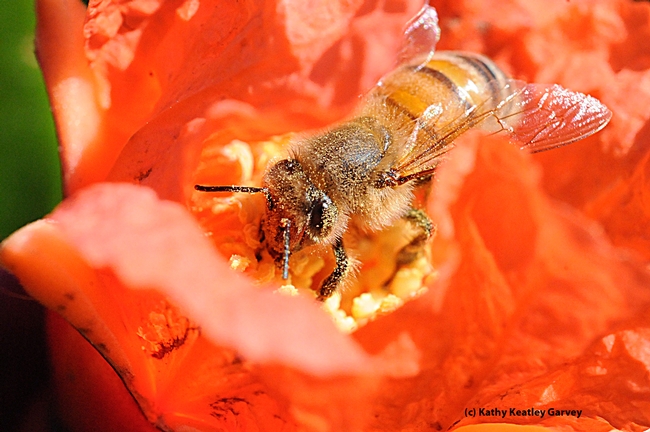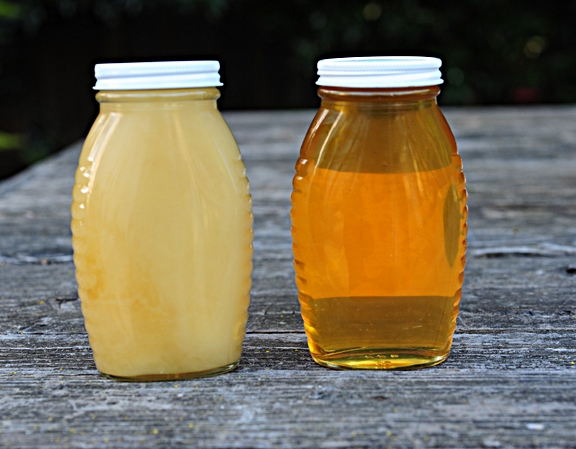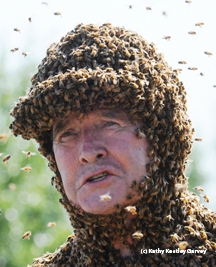Posts Tagged: Norm Gary
Honey, I hardly know you!
“My jar of honey went bad so I threw it away.”
How many times have you heard that?
It did not go “bad” but it did granulate, as honeys do. Granulation is the formation of sugar (glucose) crystals. Reheat the honey and it’s good to go — and eat.
“Most honeys granulate during storage after extended periods of time in containers,” says honey bee specialist/bee wrangler/six-decade beekeeper Norman Gary, emeritus professor in the Department of Entomology at UC Davis and author of the best-selling beginning beekeeping book, Honey Bee Hobbyist: The Care and Keeping of Bees.
“Sometimes honey granulates while still sealed in the comb,” Gary says. ”The basic reason honey granulates is that the bees have dissolved more sugar in the solution — a process called super saturation — than it can hold during storage. The tendency to granulate is determined primarily by the concentration of glucose. Excess glucose forms crystals of glucose hydrate that aggregate in a lattice in the honey."
Eric Mussen, UC Cooperative Extension specialist in Department of Entomology at UC Davis, says that nearly every variety of honey granulates over time, “since it is a supersaturated sugar solution. Hazy, crystallized, or solidified honey is not spoiled. Loosen the cap and place the container in hot water – the honey will return to its liquid state with stirring. When the sugar crystals release free water in honey, it can ferment. At that point it cannot be salvaged.”
Short-bursts in the microwave are also a good way to liquefy honey, Gary says. He advocates heating the glass jars in 30-second intervals, stopping and stirring.
“Monitor the temperature so you don’t have to heat more than necessary to achieve liquefaction.” High temperatures can "cause chemical changes that some purists consider to be heat damage.” It can also change the delicate flavors and darken the honey.
Some honeys do not crystallize or crystallize so readily. Tupelo honey, produced from the nectar of tupelo trees, does not granulate, Gary says.
As for the taste of honey, Mussen points out that honey tastes sweeter than sucrose “since it contains free fructose, which tastes sweeter to us than does sucrose. There also is free glucose in honey, but that does not taste exceptionally sweet to us.”
Meanwhile, misconceptions about honey continue to persist. Bees make honey from nectar secreted from flowers. Uninformed children may think brown cows give chocolate milk and that different colors of bees account for the different colors of honey. (Even a business professional told me last week that she thought that a specific honey bee makes orange blossom honey, and another bee makes clover honey.)
“The colors and flavors of honey are properties of the nectar collected by the bees, not of the bees producing the honey,” Mussen says. “Climate impacts the nectar. Honey produced from alfalfa bloom can be transparent or 'water white;' golden, as in 'clover' honey, or significantly darker, approaching amber, when it is produced in northern Canada, mid-western U.S., or southern U.S., respectively. If you wish to find specific varieties of honey to compare, many varieties and sources can be found at http://www.honeylocator.com/, overseen by the National Honey Board.”
Mead is another term that puzzles folks. It's an alcoholic beverage made with honey.
“Honey is the basic source of sugar for the fermentation of mead," Mussen explains. "Meads can be dry or sweet, depending upon the desire of the mead maker. With the addition of spices or fruit juices, meads are called various names: metheglin, hippocras, cyser or pymet.”
And, if you cook with honey, be aware of the properties.
“In baking and beverages honey often can be substituted directly for sugar,” Mussen says. “Lighter colored honeys usually are milder tasting, while the darker honeys are more robust. That is not always the case. Honey has around 17 percent water content, so for baking, it sometimes is good to reduce the volume of other liquids in the recipe. Also, honey tends to turn brown when baking, so reduce the heat by 25 degrees or so if less browning is desired. The finished baked product is apt to remain 'fresh' (moist) longer than sugar-based recipes, due to the presence of free fructose that attracts water moisture. Lining the measuring cup with a very thin film of cooking oil will let the honey slip right out, instead of sticking in the cup."
If you’re anxious to sample different honey varietals, head over Briggs Hall during UC Davis Picnic Day on April 20. Mussen will be offering his traditional free honey tasting. Last year he provided six kinds of honey: California buckwheat, avocado, eucalyptus, sage, orange, and cactus. In the past, visitors also tasted cotton honey, blackberry honey and starthistle honey and others.
Starthistle (Centaurea solstitialis), native to Eurasia is an exotic invasive weed hated by just about everybody but the beekeepers and the lovers of starthistle honey.
“Starthistle honey is the champagne of honey,” said Yolo County beekeeper Dennis Price of Good Bee Apiary. “It’s the best there is. However, this year’s starthistle may not be so good due to the lack of rain."
Like to cook with honey? Try the time-tested recipes on the National Honey Board website.
Beekeeper Kim Flottum, editor of Bee Culture magazine and author of the book, The Backyard Beekeeper, offers a number of recipes in his book, including these two toppings--just in time for spring!
Orange honey butter for cornbread
1/2 cup unsalted butter, at room temperate
1/8 teaspoon salt, or to taste
1 tablespoon orange zest, finely grated (1 medium to large orange)
1 tablespoon honey
Prepared corn bread
Put the softened butter into a bowl with the salt and whisk until creamy. Whisk in the orange zest and then the honey. Whisk until smooth. Warm cornbread at 250 degrees for 5 to 10 minutes. Remove from the oven and brush with a little orange honey butter. Col about 15 minutes before cutting into wedges. Serve with the remaining butter.
Orange cream spread
1 package (8-ounce) cream cheese
1/4 cup honey, mild
2 tablespoons orange juice
1/2 teaspoon orange peel or zest
Combine softened cream cheese, honey, orange juice, and orange peel. Blend well. Refrigerate at least one hour—overnight is better. Spread on rolls, muffins or croissants.

Honey bee foraging on pomegranate blossom. Pomegranate honey is the result.(Photos by Kathy Keatley Garvey)

Starthistle honey: granulated or crystalized on the left; liquid honey on the right.
Comb honey: no compromising
It's like going back to nature, but it's always been there.
Honey bee expert Norman Gary, emeritus professor in the Department of Entomology at UC Davis, says that honey is at its best "when it is sealed in the comb."
"It's packaged in the original, natural container that preserves its flavor and goodness until consumed," he said. "Some of these qualities are compromised during the harvesting process."
In his book, Honey Bee Hobbyist, the Care and Keeping of Bees, Gary writes that, "When honey is extracted, it flies through the air in tiny droplets and spreads thinly on the interior walls of the extractor tank. This exposure to air causes some flavor loss. You can enjoy the full flavor of honey be eating bite-size pieces of freshly constructed honeycomb. You can also chew beeswax like chewing gum. Swallowing beeswax is an option, but it doesn't benefit you in any way because it is indigestible."
Gary, who has been keeping bees for more than six decades, offers these tips to beekeepers in his book: "Here is a simple way to produce a small amount of comb honey. Remove a comb frame from a honey super. Replace it with a frame with the comb removed except for a 1-inch strip at the top to encourage bees to build new comb in the frame. At the beginning of an expected honey flow, place the frame in the center of the honey super immediately above the queen excluder. Bees will fill in the frame with new comb."
The honey bee, first brought to what is now the United States (Jamestown, Virginia) in 1622 and then transported to California in 1853, has long been revered for its pollination services and the products it produces. Early Americans prided themselves on finding feral honey bee colonies in bee trees and raiding the honey.
The practice continues today.
Truly, comb honey is one of nature's treasures. Many beekeepers and honey enthusiasts just cut the comb into small squares and eat it immediately. What to do if it's not consumed right away?
Gary says to seal the comb honey into zip-locked plastic bags and freeze it. It will, he says, "keep indefinitely" in the freezer.

Honey bee on comb. (Photo by Kathy Keatley Garvey)
Did you catch the buzz?
Did you catch the buzz?
It's still a troubling scene for our nation's honey bees, but it appears that the total losses for the 2011-2012 winter aren't as bad as they could be.
In other words, managed honey bee colonies appear to be holding their own. Overall, they didn't take a sharp dive last winter.
The annual survey, conducted by the U.S. Department of Agriculture (USDA), the Bee Informed Partnership, and the Apiary Inspectors of America shows that the honey bee colony losses averaged 30 percent for the winter of 2011-2012.
Compare that to 34 percent for the 2009-2010 winter, 29 percent for 2008-2009 winter; 36 percent for 2007-2008, and 32 percent for 2006-2007.
Kim Kaplan of the Agricultural Research Service (ARS) of USDA wrote in a May 23 news release that 5,572 beekeepers responded to the survey, which covered the period from October 2010 to April 2011. These 5,572 beekeepers, he said, manage more than 15 percent of the country's estimated 2.68 million colonies.
As ARS entomologist Jeff Pettis, who helped conduct the study, said: "The lack of increase in losses is marginally encouraging in the sense that the problem does not appear to be getting worse for honey bees and beekeepers."
Pettis is a familiar name among scientists, beekeepers and the beekeeping industry. He leads the USDA's chief research agency, the Bee Research Laboratory, in Beltsville, Md.
ARS plans to publish a complete analysis of the data later this year, Kaplan reports, but for now, we know that the average losses didn't fall below 30 percent. Some beekeepers, however, recorded much heavier losses.
Why care about the declining bee population?
As author Norm Gary, emeritus professor of entomology at UC Davis, says in his book, Honey Bee Hobbyist; The Care and Keeping of Bees, "Bees play a fundamental role in food production. About one-third of the food we eat, at least in the United States, can't be produced without pollination by honey bees. Fruits, vegetables, berries, some fiber crops, domestic animal feed, and oil seed crops would be in extremely short supply without honey bee pollination."
And almonds. California, the world's largest producer of almonds, has some 800,000 acres of almonds and each acre requires two hives for pollination. Without bees, no almonds.
"Can you imagine the impact on our food supply and diet if honey bees weren't available for pollination?" Gary asks. "Without them, the human diet would consist mostly of grains and fish."
Think wheat, rice and fish.
No honey, either.
Speaking of honey, you might like to try this Cranberry Oat Bread recipe provided by the National Honey Board. It hasn't been a honey of a winter for the nation's bees, but this is a honey of a recipe.
Cranberry Oat Bread
3/4 cup honey
1/3 cup vegetable oil
2 eggs
1/2 cup milk
2-1/2 cups all-purpose flour
1 cup quick-cooking rolled oats
1 teaspoon baking soda
1 teaspoon baking powder
1/2 teaspoon salt
1/2 teaspoon ground cinnamon
2 cups fresh or frozen cranberries
1 cup chopped nuts
Combine honey, oil, eggs and milk in large bowl; mix well. Combine flour, oats, baking soda, baking powder, salt and cinnamon in medium bowl; mix well. Stir into honey mixture. Fold in cranberries and nuts. Spoon into two 8-1/2 x 4-1/2 x 2-1/2-inch greased and floured loaf pans.
Bake in preheated 350 degrees oven 40 to 45 minutes or until wooden toothpick inserted near center comes out clean. Cool in pans on wire racks 15 minutes. Remove from pans; cool completely on wire racks. Makes 2 loaves.

Honey bee heading toward pomegranate blossom. (Photo by Kathy Keatley Garvey)

Honey bee packing pollen while foraging on almond blossoms at the Harry H. Laidlaw Jr. Honey Bee Research Facility, UC Davis. (Photo by Kathy Keatley Garvey)


